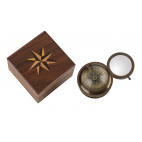- Out-of-Stock

| Los pedidos realizados el día 25 de Julio, se procesarán el día 26 por fiesta local. |




Old brass compass with glass magnifier and rotating lid to protect the glass. It includes an attractive sheesham wood box.
The compass (from the Latin "passus" ("step")) opened up the world to exploration and discovery. The principle of the magnetic needle was already known to the Chinese in the 3rd century BC and was first used by feng shui priests to tell them where and how to build. It was adapted to maritime navigation by Chinese sailors around the year 1000. The first compasses comprised a magnetic needle floating in a bowl of water, with the needle suspended on a thread or threaded through a reed. The Arabs perfected this by mounting the needle on a pivot. The compass arrived in Europe between the 10th and 11th centuries, enabling sailers to cross the oceans and explorers to discover the continents. The first instrument to resemble the modern compass is attributed to Portuguese citizen Ferrande (1483).
Old brass compass with glass magnifier and rotating lid to protect the glass. It includes an attractive sheesham wood box.
High-precision moonphase watch from the prestigious IMEX Marine brand. Clear acrylic frame. Made in Spain. 1 year warranty. 13.6x136x3 cm.
50 seconds brass sandglass with rosewood box.
IMEX barometer, a great benchmark in quality measurement devices. This elegant IMEX barometer analyses pressure variations allowing it to predict the weather. Made with brass plated metal. Made in Spain. Guaranteed 1 year. 11.5x3.5x11.5 cm.
Handmade reproduction of a fog horn, used as a maritime signaling instrument. Made of polished brass.
Brass compass with dial mounted in an acacia wood box with anchor motif.
NAUTICAL CLOCK. Retro and unique clock decorated with a beautiful compass rose. Made in metal.